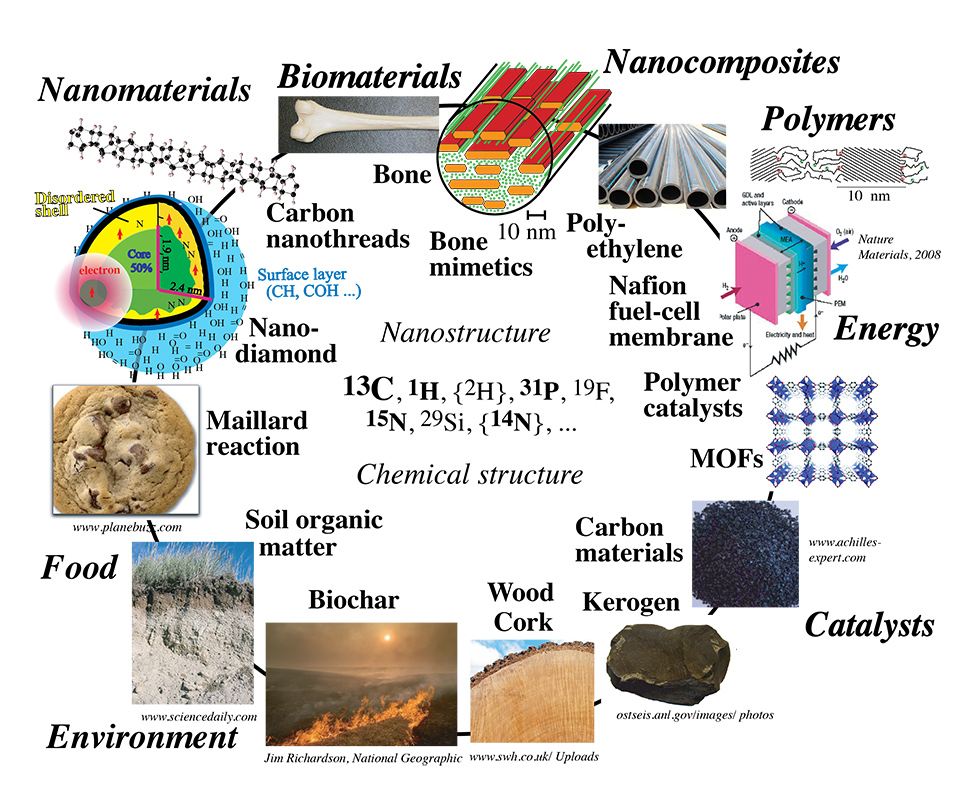Klaus Schmidt-Rohr
 Professor of Chemistry
Professor of Chemistry
Degrees
University of Mainz, Germany, PhD
Profile
Research Interests
Our group studies the composition and nanoscale structure of polymer materials, nanothreads, metal–organic frameworks, carbon materials, nanocomposites, and natural organic matter, using a variety of quantitative, selective, or two-dimensional nuclear magnetic resonance (NMR) experiments, many of which were developed by us. We have also introduced new methods for analyzing scattering data of nanostructured materials. This dual approach has enabled us to “solve” important aspects of the structure of the Nafion fuel-cell membrane, of the nanocomposite in bone, and of the chain trajectories in semicrystalline polymers. Based on such structural insights, we strive to understand materials properties and sometimes propose improved synthesis or processing conditions.

We also examine basic aspects of classical thermodynamics and chemical energy. For instance, we have worked out quantitatively how batteries store energy in relatively weak bonds of certain metals and have developed the oxygen theory of combustion and respiration energetics: Fire is hot due to release of the chemical energy stored in the relatively weak double bond of oxygen; the human body obtains most of its energy not from food but from oxygen in the air.
Selected Publications
- “Immobilized 13C-Labeled Polyether Chain Ends Confined to the Crystallite Surface Detected by Advanced NMR” S. Yuan, K. Schmidt-Rohr, Sci. Adv. 6, eabc0059 (2020).
- “Multinuclear Solid-State NMR of Complex Nitrogen-Rich Polymeric Microcapsules: Weight Fractions, Spectral Editing, Component Mixing, and Persistent Radicals” S. Yuan, P. Duan, D. L. Berthier, G. León, H. Sommer, J.-Y. de Saint-Laumer, K. Schmidt-Rohr, Solid State NMR 106, 101650 (2020).
- “A Silk-like Protein with Organic Radicals Identified in Oyster Adhesive by Solid-State NMR” K.J. Fritzsching, P. Duan, M. A. Erik, A. M. Tibabuzo Perdomo, P. Kenny, J. J. Wilker, K. Schmidt-Rohr, ACS Applied Bio Materials 2, 2840-2852 (2019).
- “Avoidance of Density Anomalies as a Structural Principle for Semicrystalline Polymers: The Importance of Chain Ends and Chain Tilt” K. J. Fritzsching, K. Mao, K. Schmidt-Rohr, Macromolecules 50, 1521-1540 (2017).
- “Quantifying Molecular Mixing and Heterogeneity in Pharmaceutical Dispersions at Sub-100-nm Resolution by Spin Diffusion NMR” P. Duan, M. S. Lamm, F. Yang, W. Xu, D. Skomski, Y. Su, K. Schmidt-Rohr, Mol. Pharmaceutics 17, 3567-3580 (2020).
- “Quick, Selective NMR Spectra of C-OH Moieties in 13C-enriched Solids” P. Duan, K. Schmidt-Rohr, J. Magn. Reson. 301, 80-84 (2019).
- “Composite-Pulse and Partially Dipolar Dephased MultiCP for Improved Quantitative Solid-State 13C NMR” P. Duan, K. Schmidt-Rohr, J. Magn. Reson. 285, 68-78 (2017).
- Perfect and Defective 13C-Furan Nanothreads from High-Pressure Syntheses Analyzed by 13C NMR” B. Matsuura, S. Huss, Z. Zheng, S. Yuan, T. Wang, B. Chen, J. V. Badding, D. Trauner, E. Elacqua, A. C. T. Van Duin, V. H. Crespi, K. Schmidt-Rohr, J. Am. Chem. Soc. 143, 9529-9521 (2021).
- The Chemical Structure of Carbon Nanothreads Analyzed by Advanced Solid-State NMR” P. Duan, X. Li, S. J. Juhl, B. Chen, D. Koeplinger, V. H. Crespi, J. V. Badding, K. Schmidt-Rohr, J. Am. Chem. Soc. 140, 7658-7666 (2018).
- “Structure of the Polymer Backbones in PolyMOF Materials” G. Mileo, S. Yuan, S. Ayala, P. Duan, R. Semino, S. M. Cohen, K. Schmidt-Rohr, G. Maurin, J. Am. Chem. Soc. 142, 10863–10868 (2020).
- “Polymer Infiltration into Metal-organic Frameworks in Mixed-matrix Membranes Detected In Situ by NMR” P. Duan, J. C. Moreton, R. Semino, G. Maurin, S. M. Cohen, K. Schmidt-Rohr, J. Am. Chem. Soc. 141, 7589-7595 (2019).
- “Synthesis and Reactivity of Zr MOFs Assembled from PNNNP-Ru Pincer Complexes” A. A. Kassie, P. Duan, M. Gray, K. Schmidt-Rohr, P. M. Woodward, C. R. Wade Organometallics 38, 3419-3428 (2019).
- “Abundant Nonprotonated Aromatic and Oxygen-Bonded Carbons Make Humic Substances Distinct from Biopolymers” X. Cao, K. Schmidt-Rohr, Environ. Sci. Technol. Lett. 5, 476-480 (2018).
- “Evidence of Major Input of Riverine Organic Matter into the Ocean” X. Cao, G. R. Aiken, K. D. Butler, T. G. Huntington, W. M. Balch, J. Mao, K. Schmidt-Rohr, Org. Geochem. 116, 62-76 (2017).
- “A Major Step in Opening the Black Box of High-Molecular-Weight Dissolved Organic Nitrogen by Isotopic Labeling of Synechococcusand Multi-Bond Two-Dimensional NMR” X. Cao, M. R. Mulholland, J. R. Helms, P. W. Bernhardt, P. Duan, J. Mao, K. Schmidt-Rohr, Analyt. Chem. 89, 11990-11998 (2017).
- “Advanced solid-state NMR spectroscopy of natural organic matter” J.-D. Mao, X. Cao, D. C. Olk, W. Chu, K. Schmidt-Rohr. Prog. Nucl. Magn. Reson. Spectros. 100, 17-100 (2017).
- “Oxygen Is the High-Energy Molecule Powering Complex Multicellular Life: Fundamental Corrections to Traditional Bioenergetics” K. Schmidt-Rohr, ACS Omega 5, 2221-2233 (2020).
- “How Batteries Store and Release Energy: Explaining Basic Electrochemistry” K. Schmidt-Rohr, J. Chem. Educ. 95, 1801-1810 (2018).
- “Why Combustions Are Always Exothermic, Yielding About 418 kJ per Mole of O2” K. Schmidt-Rohr, J. Chem. Educ. 92, 2094-2099 (2015).
- “Analysis of Two Definitions of the Mole That Are in Simultaneous Use, and Their Surprising Consequences” K. Schmidt-Rohr, J. Chem. Educ. 97, 597-602 (2020).
- “Expansion Work without the External Pressure, and Thermodynamics in Terms of Quasistatic Irreversible Processes” K. Schmidt-Rohr, J. Chem. Educ. 91, 402-409 (2014).